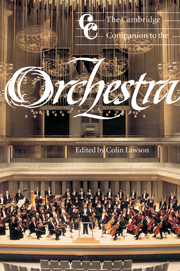Book contents
- Frontmatter
- 1 The history of the orchestra
- 2 The development of musical instruments: national trends and musical implications
- 3 The orchestral repertory
- 4 From notation to sound
- 5 The art of orchestration
- 6 The history of direction and conducting
- 7 International case studies
- 8 The revival of historical instruments
- 9 Recording the orchestra
- 10 Training the orchestral musician
- 11 The life of an orchestral musician
- 12 Historical recordings of orchestras
- 13 The orchestral composer
- 14 Educational programmes
- 15 The future of the orchestra
- Notes
- Appendices
3 - The orchestral repertory
Published online by Cambridge University Press: 28 September 2011
- Frontmatter
- 1 The history of the orchestra
- 2 The development of musical instruments: national trends and musical implications
- 3 The orchestral repertory
- 4 From notation to sound
- 5 The art of orchestration
- 6 The history of direction and conducting
- 7 International case studies
- 8 The revival of historical instruments
- 9 Recording the orchestra
- 10 Training the orchestral musician
- 11 The life of an orchestral musician
- 12 Historical recordings of orchestras
- 13 The orchestral composer
- 14 Educational programmes
- 15 The future of the orchestra
- Notes
- Appendices
Summary
Beginnings
When musicians were first assembled in numbers surpassing the usual small consort of wind and string players, it was not to play by themselves but always to accompany singers and dancers at the theatre. The Florentine intermedi of the sixteenth century and Monteverdi's Orfeo in Mantua (1607) required considerable instrumental forces, and in the case of Orfeo, these were listed in the score, with specific assignments indicated throughout the piece. Yet the musicians in Orfeo are more an ensemble of soloists than a real orchestra; there was probably no more than a single player to the part. Louis XIII's 24 violons du Roi were apparently the first group in which the strings played in sections, but they still performed theatrical music, as did their English followers, King Charles's Four and Twenty Fiddlers. Jean-Baptiste Lully left a few marches and other short pieces for orchestra that seem not to belong to any of his operas or comédies-ballets, but they do not differ appreciably from his theatrical music.
Paradoxically, while the repertory of these ‘pre- and proto-orchestras’ did not comprise much autonomous orchestral music, the words that would designate the orchestral genres of the future did not, originally, refer to orchestral music at all. In the first instance, the terms ‘symphony’ and ‘concerto’ designated vocal genres (as in Giovanni Gabrieli's Sacrae symphoniae of 1597 or Lodovico Viadana's Concerti ecclesiastici of 1602). Even in the early eighteenth century, when a ‘symphony’ was definitely an instrumental piece, it was not consistently distinguished from genres that today would fall under the category of chamber music: the names ‘symphony’, ‘sonata’, ‘trio’, ‘quartet’ etc. were often used interchangeably.
- Type
- Chapter
- Information
- The Cambridge Companion to the Orchestra , pp. 42 - 70Publisher: Cambridge University PressPrint publication year: 2003



